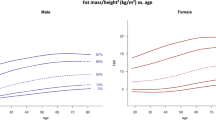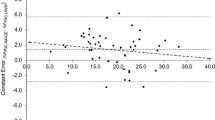Abstract
Objective:
The aims of this study were to validate BOD POD in a wide sample of healthy and independent Mexican elderly men and women subjects using the 4 compartment (4C) model as the reference method, and to evaluate the assumptions of the densitometric two-compartment (2C) model.
Design:
Cross-sectional study designed to assess body composition and validation of a method based on 2C model (BOD POD).
Setting:
Urban and rural regions of Sonora, Mexico.
Subjects:
Two hundred and two free-living subjects ⩾60 years old were completed in this study.
Methods:
Body density and body fat were measured by the BOD POD, total body water by deuterium dilution and total body bone ash by dual energy X-ray absorptiometry. Body composition was determined using Baumgartner's equation.
Results:
Percent body fat by the 4C model was 31.2 and 42.5% in men and women, respectively (P<0.001). Group mean accuracy of body fat by BOD POD against that of the 4C model showed an effect of sex (P<0.001), but not the method (P=0.27). Results of individual accuracy showed no significant difference with the identity line and the slope was significantly different from zero or a slope similar to one. Precision assessed by model R2 was high for all subjects and for men and women by separate. The standard error of the estimate was low for all and for men and women by separate. Bland and Altman analysis showed no significant bias.
Conclusion:
The BOD POD technique is a valid and reliable method compared to the 4C model and it could be applied in subjects with similar physical and anthropometric characteristics to subjects of this study.
Sponsorships:
The study was funded by CONACYT, Mexico (J37891-M) and IAEA (Research contract no. 12694/R0).
This is a preview of subscription content, access via your institution
Access options
Subscribe to this journal
Receive 12 print issues and online access
$259.00 per year
only $21.58 per issue
Buy this article
- Purchase on Springer Link
- Instant access to full article PDF
Prices may be subject to local taxes which are calculated during checkout


Similar content being viewed by others
References
Aleman-Mateo H, Romero JE, Morales NM, Salazar G, Triana MH, Valencia ME (2004). Body composition by three-compartment model and relative validity of some methods to assess percentage body fat in Mexican healthy elderly subjects. Gerontology 50, 366–372.
Baumgartner RN, Heymsfield SB, Lichtman S, Wang J, Pierson RN (1991). Body composition in elderly people: effect of criterion estimates on predictive equations. Am J Clin Nutr 53, 1345–1353.
Bland JM, Altman DG (1986). Statistical methods for assessing agreement between two methods of clinical measurement. Lancet 1, 307–310.
Bosy-Westphal A, Mast M, Eichhorn C, Becker C, Kutzner D, Heller M et al. (2003). Validation of air-displacement plethysmography for estimation of body fat mass in healthy elderly subjects. Eur J Nutr 42, 207–216.
Brohall G, Behre CJ, Hulthe J, Wikstrand J, Fagerberg B (2006). Prevalence of diabetes and impaired glucose tolerance in 64-year-old Swedish women: experiences of using repeated oral glucose tolerance tests. Diabet Care 29, 363–367.
Brozek J, Grande F, Anderson Jt, Keys A (1963). Densitometric analysis of body composition: revision of some quantitative assumptions. Ann NY Acad Sci 110, 113–140.
Clasey JL, Kanaley JA, Wideman L, Heymsfield SB, Teates CD, Gutgesell ME et al (1999). Validity of methods of body composition assessment in young and older men and women. J Appl Physiol 86, 1728–1738.
Dempster P, Aitkens S (1995). A new air displacement method for the determination of human body composition. Med Sci Sports Exerc 12, 1692–1697.
Deurenberg P, Deurenberg-Yap M (2003). Validity of body composition methods across ethnic population groups. Forum Nutr 56, 299–301.
Deurenberg P, Deurenberg-Yap M, Guricci S (2002). Asians are different from Caucasians and from each other in their body mass index/body fat percent relationship. Obes Rev 3, 141–146.
Fields DA, Hunter GR (2004). Monitoring body fat in the elderly: application of air-displacement plethysmography. Curr Opin Clin Nutr Metab Care 7, 11–14.
Fields DA, Wilson GD, Gladden LB, Hunter GR, Pascoe DD, Goran MI (2001). Comparison of the BOD POD with the four-compartment model in adult females. Med Sci Sports Exerc 33, 1605–1610.
Forbes GB 1987. Human body composition. Human body composition. Growth, Aging, Nutrition, and Activity. Springer-Verlag: New York.
Goodpaster BH, Krishnaswami S, Harris TB, Katsiaras A, Kritchevsky SB, Simonsick EM et al. (2005). Obesity, regional body fat distribution, and the metabolic syndrome in older men and women. Arch Intern Med 165, 777–783.
Goran MI, Toth MJ, Poehlman ET (1998). Assessment of research-based body composition techniques in healthy elderly men and women using the 4-compartment model as a criterion method. Int J Obes Relat Metab Disord 22, 135–142.
Heymsfield SB, Wang J, Lichtman S, Kamen Y, Kehayias J, Pierson NP (1989). Body composition in elderly subjects: a critical appraisal of clinical methodology. Am J Clin Nutr 50, 1167–1175.
Katz S, Downs TD, Cash HR, Grotz RC (1970). Progress in development of the index of ADL. Gerontologist 10, 20–30.
Kyle UG, Genton L, Slosman DO, Pichard C (2001a). Fat-free and fat mass percentiles in 5225 healthy subjects aged 15 to 98 years. Nutrition 17, 534–541.
Kyle UG, Morabia A, Slosman DO, Mensi N, Unger P, Pichard C (2001b). Contribution of body composition to nutritional assessment at hospital admission in 995 patients: a controlled population study. Br J Nutr 86, 725–731.
Lowik MR, Schrijver J, Odink J, van den Berg H, Wedel M, Hermus RJ (1990). Nutrition and aging: nutritional status of apparently healthy elderly (Dutch nutrition surveillance system). J Am Coll Nutr 9, 18–27.
Luke A, Durazo-Arvizu R, Rotimi C, Prewitt TE, Forrester T, Wilks R et a.l (1997). Relation between body mass index and body fat in black population samples from Nigeria, Jamaica, and the United States. Am J Epidemiol 145, 620–628.
Pace N, Rathburn EN (1945). Studies on body composition III: the body water and chemically combined nitrogen content in relation to fat content. J Biol Chem 158, 685–691.
Schoeller DA, Kushner RF, Taylor P, Dietz WH, Bandini L (1985). Measurement of total body water: isotope dilution techniques. Report of the Sixth Ross Conference on Medical Research. Ross Laboratories: Ohio. pp. 24–29.
Siri WE (1961). Body composition from fluid spaces and density: analysis of methods. In: Brozek J, Henschel A (eds). Techniques for measuring body composition. Washington DC: National Academy of Sciences. National Research Council. pp. 223–244.
The Health National Survey 2 (ENSA-2000) (2000). The health of the adults. National Institute of Public Health, Mexico.
Withers RT, Laforgia J, Heymsfield SB (1999). Critical appraisal of the estimation of body composition via two-, three-, and four-compartment models. Am J Hum Biol 11, 175–185.
Yamwong P, Assantachai P, Amornrat A (2000). Prevalence of dyslipidemia in the elderly in rural areas of Thailand. Southeast Asian J Trop Med Public Health 31, 158–162.
Yee AJ, Fuerst T, Salamone L, Visser M, Dockrell M, Van Loan M et al. (2001). Calibration and validation of an air-displacement plethysmography method for estimating percentage body fat in an elderly population: a comparison among compartmental models. Am J Clin Nutr 74, 637–642.
Acknowledgements
We thank CONACYT (J37891-M), IAEA (Research contract No. 12694/R0) and CIAD, AC for the funds. We want to thank volunteers and their family for their unconditional participation, and as well as Bertha I Pacheco, Ana Cristina Gallegos, Francisco Navarrete, F Angelica Pérez for their technical assistance. We thank to Dr Martha del Prado responsible of the Nutrition Research Unit, at Centro Medico Nacional, Siglo XXI, IMSS for analysis of deuterium by mass spectrometry.
Author information
Authors and Affiliations
Corresponding author
Additional information
Guarantor: ME Valencia.
Contributors: HA-M is the project leader and contributed to the design, field work, data collection, analysis and writing of the manuscript. RHH contributed to the field work, data analysis and writing of the manuscript. JE-R contributed to the design, data analysis and writing of the manuscript. ROM contributed to the data collection, data analysis and writing of the manuscript. RU contributed to the field work coordination, data collection and writing of the manuscript. MEV contributed to the design, data analysis and writing of manuscript. None of the contributing authors had any financial or personal interests in any of the bodies sponsoring this research.
Rights and permissions
About this article
Cite this article
Alemán-Mateo, H., Huerta, R., Esparza-Romero, J. et al. Body composition by the four-compartment model: validity of the BOD POD for assessing body fat in mexican elderly. Eur J Clin Nutr 61, 830–836 (2007). https://doi.org/10.1038/sj.ejcn.1602597
Received:
Revised:
Accepted:
Published:
Issue Date:
DOI: https://doi.org/10.1038/sj.ejcn.1602597
Keywords
This article is cited by
-
Predictive equations for fat mass in older Hispanic adults with excess adiposity using the 4‐compartment model as a reference method
European Journal of Clinical Nutrition (2023)
-
Effect of total body water estimates via bioimpedance on bod pod-based three-compartment body fat models
European Journal of Clinical Nutrition (2022)
-
Prediction of fat-free mass by bioelectrical impedance analysis in older adults from developing countries: A cross-validation study using the deuterium dilution method
The Journal of nutrition, health and aging (2010)
-
Evaluation of air-displacement plethysmography and bioelectrical impedance analysis vs dual-energy X-ray absorptiometry for the assessment of fat-free mass in elderly subjects
European Journal of Clinical Nutrition (2008)



